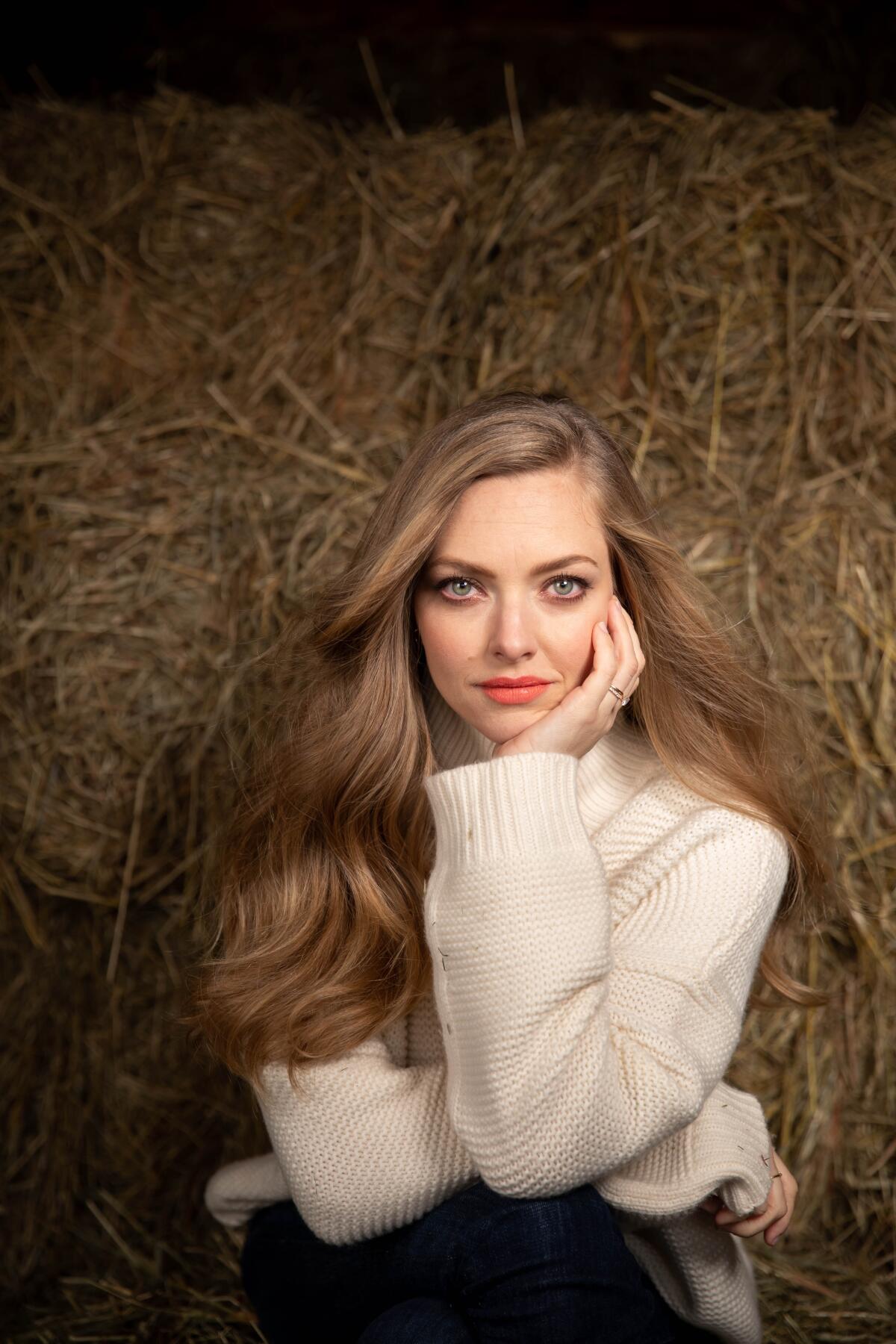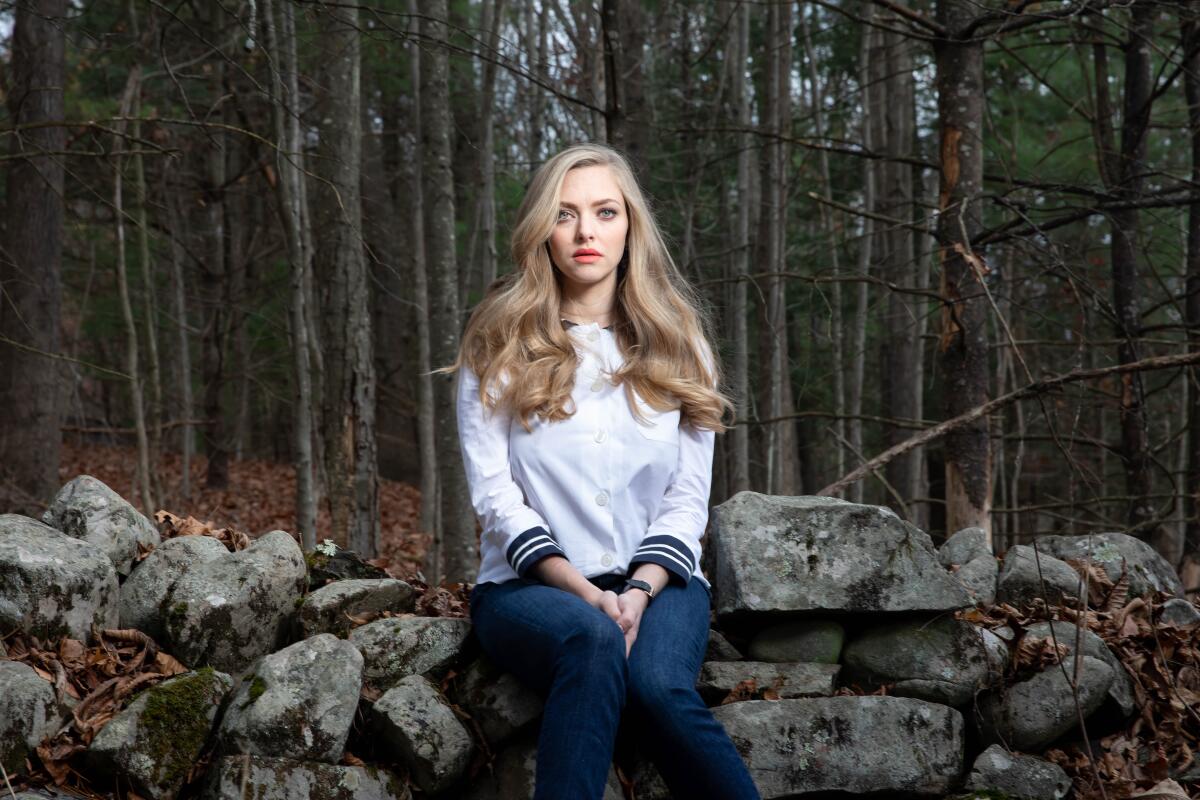Amanda Seyfried embraces the silences in David Fincher’s ‘Mank’

- Share via
How excited was Amanda Seyfried at the prospect of starring in a David Fincher film? “I would have played a piece of wood,” she says with a laugh. Luckily for all involved, the role as silver screen star Marion Davies for Fincher’s Netflix release “Mank” was nowhere near as stiff. In fact, Seyfried delivers a scene-stealing performance, one that neither of the two initially took for granted would happen for the story of “Citizen Kane” screenwriter Herman J. Mankiewicz and his friendship with the actress and companion to media mogul William Randolph Hearst.
Fincher recalls an initial 1 a.m. Skype with Seyfried after she’d finished a long day of shooting another film. As hard as it may be to fathom, the seminal director insists he was “sort of panicking” through his pitch to her. He was trying to convey aspects of the film he envisioned beyond what was on the written page but was having trouble expressing his thoughts.
“She was actively participating in helping me to find the right words to pitch her on this project. And it wasn’t like she did it two or three times. She did it, like, three times a minute for 45 minutes. After a while, it became obvious that this was sort of a second nature thing that she does to make other people feel comfortable or to make other people feel heard. And, by the end of it, when we hung up, I thought, ‘the woman who has to give semi-inebriated little Herman Mankiewicz a tour of her [private] zoo, has to have this skill or has to have this tributary to her behavior. It has to be something that’s sort of innate.’ It’s the den-mother thing.”
Even as Fincher was telling himself, “‘If she says yes, take her up on it,’ because there was something really special about that,” Seyfried was feeling an urgency of her own.
“I never expect these directors to know me or want to work with me. It’s always a hope but you don’t hold your breath,” she says. “I barely had time to read the script, but you snap to it with an opportunity like this.”
Known for movies about crime and chaos, director David Fincher delivers a personal tale with “Mank.”
But there was still the issue of that other film she was shooting — an independent production called “Things Heard & Seen” filming in the New York area — and the two projects would certainly overlap. Seyfried made it work, shooting the indie film nights in New York and then jumping on 6 a.m. flights to Los Angeles to work on “Mank” later that same day. The actress says she’s never worked so hard in her life but to do so with Fincher was a “dream.”
Her character was a rare historical figure for Seyfried to portray. Over two decades, Davies starred in over 40 features spanning both the silent and talkie eras. Many of those films were financed by Hearst (portrayed by Charles Dance). To the general public, she was his mistress but, in private, their relationship was much more complicated.
Their social circle included many Hollywood luminaries of the ‘20s and ‘30s including Mankiewicz, a screenwriter who had a special rapport with Davies. Eventually, Mankiewicz (played by Gary Oldman) won an Academy Award for cowriting “Citizen Kane,” a film whose central characters are unquestionably similar to Hearst and Davies.
Fincher’s film chronicles the weeks in 1940 that Mank, as he was called, spent crafting that screenplay while revisiting his friendship with Davies, among others, in flashbacks almost a decade prior.
“I think Marion’s so smart and she knows how to play certain situations in order to get the most out of it,” Seyfried says. “She’s not someone who wants to create drama at all. She just wants everybody to enjoy themselves. But you have to be kind of smart in certain ways to know how to manipulate and negotiate your way through these big conversations that these big industry men are having. She knows how to survive and make the best of it.”
Despite Davies’ catalog of motion pictures, researching how the actress behaved and sounded off screen was thorny. There were some audio recordings and an autobiography (Seyfried refers to it as “a bizarre read”), but it was films like 1936’s “Cain and Mabel” that gifted her with insight into Davies’ mannerisms. Seyfried notes, “Something that lived with me was just the way she listened and the way she would move her neck and her jaw. It was just very physical.”
As the daughter of a father who still collects 16- and 35-mm film prints, Seyfried grew up with an education in classic Hollywood pictures of Davies’ particular era. Knowing the tone and the feel of the time wasn’t the issue. Finding the subtle “Brooklynese” that Fincher wanted in her voice was the trickier part.
“I was like, ‘Can I do that? Is that how it’s going to be? Because I don’t know if I can,’ ” Seyfried says, noting the lack of reference material to her off-screen speaking voice. “She had a stutter in real life. We didn’t even go there in the film.”
One of Seyfried’s most impressive moments in “Mank” occurs during a climactic scene that renders her speechless. A known alcoholic, Mankiewicz crashes a New Year’s Eve dinner at Hearst’s castle angry over the manipulative newsreels he knows Hearst and MGM head honcho Louis B. Mayer (Arliss Howard) conspired over to influence a contested 1934 race for the governor of California. As Mank delivers an epic rant, Seyfried conveys Davies’ horrifying realization that her friend is torching his relationships with Mayer, Hearst and even herself.
“I love being a silent actress. There’s so much more room to play when you don’t have lines because sometimes lines can get in the way,” Seyfried notes. “And the whole scene is really just listening and connecting to Hearst because Mank is such a disappointment and he’s undermining the whole relationship that Marion and Hearst have.”
Initially, according to Fincher, Seyfried thought — or was likely joking — that because the scene required no dialogue it equated to four days off. Fincher recalls saying, “Let me disabuse you of that. You are the mortar that holds every single tile in this mosaic. And I am going to be cutting off every plume of ostrich feather that is on each of your shoulders. You’re the fulcrum of this whole scene, the pivot point. And she blanched for a second, kind of going, ‘Oh.’”

Seyfried reveals it was her favorite scene to shoot specifically because of Fincher’s guidance.
“There’s like a bajillion subtleties in Fincher’s movies and that’s sometimes what takes so long to get. And that’s why he does a lot of takes, but it’s for a reason,” Seyfried says. “You saw a sea of information in my eyes and that’s because we did it over and over again. And the performances that were coming at me were just incredible and hard to not take in. I mean, everything that’s happening with me in that scene is Charles and Gary and Arliss, and seeing how angry he’s getting and how stoic Charles is and how f— up Gary is. It just takes a village.”
More to Read
From the Oscars to the Emmys.
Get the Envelope newsletter for exclusive awards season coverage, behind-the-scenes stories from the Envelope podcast and columnist Glenn Whipp’s must-read analysis.
You may occasionally receive promotional content from the Los Angeles Times.








